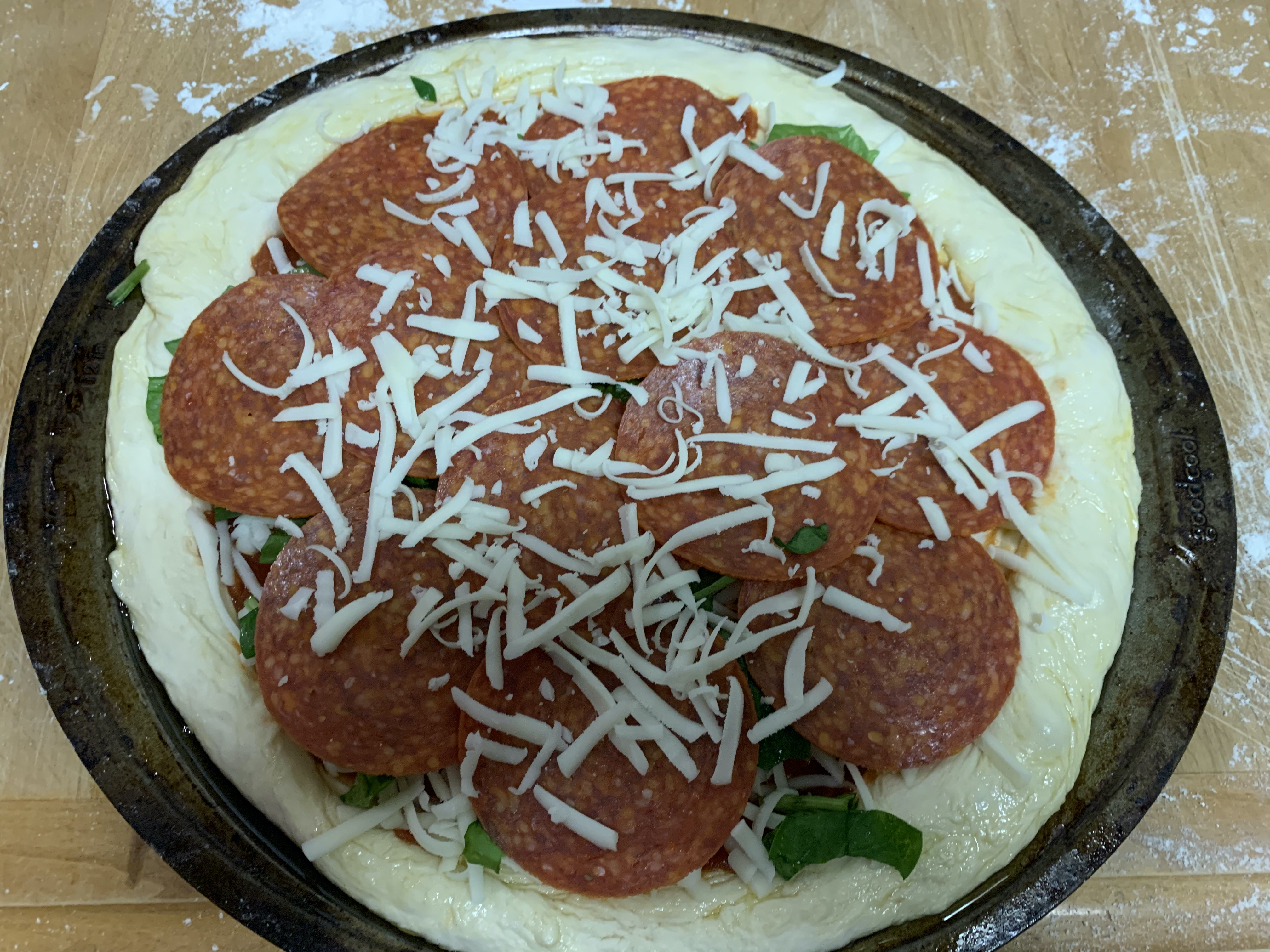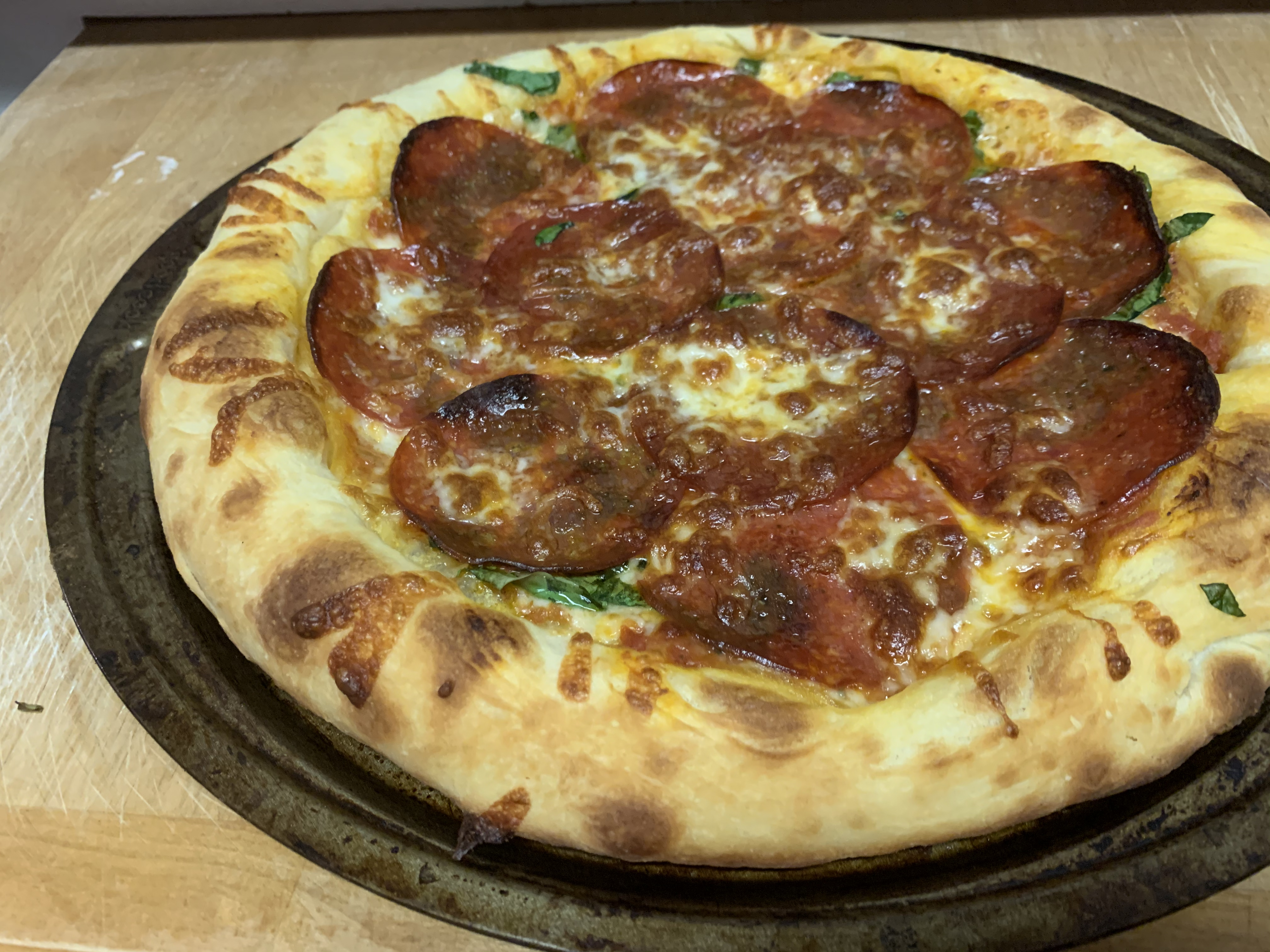Let me take you back to a moment that changed my life. Flashback to a pre-pandemic America, everything is open, strip mall parking lots are packed, people are wearing pants, and we’re all holding hands and breathing on each other or whatever the hell we all use to do. A hungry future food writer (me) is waiting in line to grab a bite to eat at a Mod Pizza when his eyes glance over at some promotional material hanging in the store. “We make our dough the right way: just flour, water, olive oil, and a pinch of sea salt.”
Whoa whoa whoa, wait what?
“Is that all that’s in pizza dough?” I asked a friend. “You mean to tell me I’ve been living my entire life buying pizza when I could’ve just made my own goddamn pizza with four freaking ingredients?” (It turns out to be slightly more than that… but not much.)
Since that day, I haven’t had a single reason to buy a frozen pizza or pre-made dough. And my pizzas have been better for it. Yes, it turns out that making pizza dough is one of the easiest kitchen tasks you can do. Truly. So this Super Bowl weekend, don’t spend a fortune getting your pies delivered or waste money picking up pre-made “fresh” dough, instead let’s learn to make our own.
You won’t need any special tools (no pizza stones, steels, peels, or special ovens required) and you probably have all the ingredients sitting in your kitchen pantry right now — all just waiting to get turned into a delicious homemade New York-style thin-crust pizza!
Ingredients

Traditional pizza dough is made with just five ingredients: flour, water, olive oil (and even this ingredient is debatable), salt, and active dry yeast, but because we’re assuming you’re working with a conventional electric home oven that isn’t capable of getting nearly as hot as the type of pizza oven the pros use, we’re going to alter this recipe slightly to ensure your crust is nice, crispy, and brown.
To yield four 12 inch pizza pies you’ll need:
- 5 cups of flour (+ a bit more to fine-tune)
- 2 cups of warm water (+ a bit more to fine-tune)
- 1 packet of active dry yeast (about 2 1/4 tsp)
- 2 tablespoons of Extra Virgin Olive Oil
- 1 tablespoon of sugar
- 2/3 tablespoon of salt
Why sugar? Two reasons: 1) It’ll help to feed the yeast and make the dough rise faster and 2) It’ll help your pizza brown better (along with the olive oil) in your low-temperature oven. If you feel like a tablespoon of sugar is too much, you’re wrong, it’s not, and don’t worry this won’t result in the sweetest pizza you’ve ever tasted — the yeast will devour it and you you won’t even notice sweetness.
Do you need bread flour? No, All-Purpose will do in a pinch, but bread flour will give you a chewy end product, which is more desirable for pizza.
Turning It All Into Dough
First, in a warm cup of water combine your yeast and sugar until the yeast has activated (bubbled up). Combine your 5 cups of flour, 2/3 tablespoon of salt, olive oil, and warm yeast water in a large bowl and slowly work in an additional cup of warm water while folding your dough into itself until it’s at the consistency you like. This ratio of flour to water should get you near the ballpark of where you want your dough to be, which is semi-wet and sticky, but not sticky enough to stick to your fingers.
Knead your dough with a rubber spatula (or your hands if you feel like transferring to a flour-dusted surface or have a large enough bowl) until the ingredients combine into a smooth clump-less consistency. You’re may find yourself adding in more flour and water here and there to get it just right.
You’re going to have to eye-ball this step and call it when it looks right to you, but If you pick out a chunk of your dough and it tears like this:

It’s not ready. Look how chunky that is! No good.
When it’s stretchy and smooth like this without any tearing:

You’ve hit the sweet spot, give those arms a break!
Once your dough is smooth and semi-sticky, transfer from your mixing bowl to a flour-dusted surface and tear it into two large chunks with your hands (a twisting motion works best here)

Repeat the process until you have four chunks of dough of approximately the same size and weight. Store your four dough balls in well-oiled containers and wait for the magic to happen.
If you’re making the pizza the same day, you might as well leave your dough out to rise. If you’re making this dough in advance (which we recommend) go ahead and toss it in the refrigerator. After about 2-4 hours (slightly longer if refrigerated), your dough should have doubled in size.

Apologies for my lighting. I promise that the dough didn’t turn green.
Why You Should Make Your Pizza Dough In Advance
If you don’t tear through four pizzas in one evening (no judgment if you do, it’s the Super Bowl, we get it) you’ll find that your dough consistently improves as it ferments. Once your dough smells slightly beer-like (2-3 days), you’re in the sweet spot. Prepare to enter a world of crispy almost sour-dough like crust.
When it comes to good pizza dough, time is the most essential seasoning.
Optional Ways To Spice Up Your Dough
If plain pizza dough isn’t what you’re after, feel free to infuse a helping of Italian herbs and garlic powder into your olive oil before mixing your ingredients. It’s an easy way to flavor your crust, but we strongly recommend going the fresh route and just implementing those ingredients as toppings on the pie itself.
Tips For Stretching And Cooking Your Pizza
Hey friend, all we said we’d do is tell you how to make dough. If you want to turn that dough into a pizza, that’s your business… All right fine, we won’t leave you hanging like that.
First things first, pre-heat that oven as high as it goes (probably 550-575 degrees Fahrenheit). Place your dough on a well-dusted surface (flour, semolina, or cornmeal) and form a circular crust along the rim of the dough gently with your fingers.

Since we used olive oil in our dough, it should be fairly easy to work with so you won’t need a rolling pin or any special tools to stretch out your pizza. The key for first-timers is to be patient and move slowly here, you don’t need to toss your pizza in the air (though, there is a good reason to), it’s more important that you don’t tear your dough.
Instead let gravity do the work here, gently lift up your dough with two hands and work your way around, lifting slightly and letting the weight of the dough do the stretching. If you really lack the confidence, watch a YouTube tutorial but don’t beat yourself up about your pizza not being perfectly circular, it might turn out as a weird oblong shape. That’s okay, prettier pizzas will come with practice, all that’s really important is that your pizza tastes good, which it should!
Once the dough is stretched, transfer it to a well-oiled flat 12-inch pan or steel cookie sheet if you have one. If you don’t, use parchment paper. If you don’t have parchment paper, use aluminum foil.

Top your dough with sauce (I use Rao’s, but feel free to use any pizza sauce) [true Italian pizza sauce is just canned tomatoes crushed by hand.], then cheese (I like whole milk mozzarella, people can debate which is best until the cows come home), then your toppings of choice (I did spinach and pepperoni), then finish with more cheese, slide into the oven, wait about 8-10 minutes or until the cheese has a nice bubbly brown and bam!
You just made your first homemade pizza. Look at that cornice! The puff!








